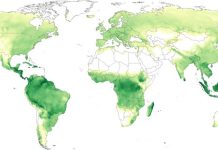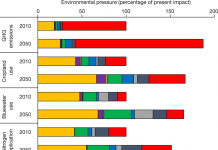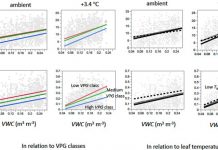Kyle Frankel Davis,Maria Cristina Rulli,Antonio Seveso & Paolo D’Odorico. Increased food production and reduced water use through optimized crop distribution. Nature Geoscience 10, 919–924 (2017) doi:10.1038/s41561-017-0004-5
Abstract
Growing demand for agricultural commodities for food, fuel and other uses is expected to be met through an intensification of production on lands that are currently under cultivation. Intensification typically entails investments in modern technology — such as irrigation or fertilizers — and increases in cropping frequency in regions suitable for multiple growing seasons. Here we combine a process-based crop water model with maps of spatially interpolated yields for 14 major food crops to identify potential differences in food production and water use between current and optimized crop distributions. We find that the current distribution of crops around the world neither attains maximum production nor minimum water use. We identify possible alternative configurations of the agricultural landscape that, by reshaping the global distribution of crops within current rainfed and irrigated croplands based on total water consumption, would feed an additional 825 million people while reducing the consumptive use of rainwater and irrigation water by 14% and 12%, respectively. Such an optimization process does not entail a loss of crop diversity, cropland expansion or impacts on nutrient and feed availability. It also does not necessarily invoke massive investments in modern technology that in many regions would require a switch from smallholder farming to large-scale commercial agriculture with important impacts on rural livelihoods.
——————————————————————————–
Pasquale Borrelli,David A. Robinson,Larissa R. Fleischer,Emanuele Lugato,Cristiano Ballabio,Christine Alewell,Katrin Meusburger,Sirio Modugno,Brigitta Schütt,Vito Ferro,Vincenzo Bagarello,Kristof Van Oost,Luca Montanarella & Panos Panagos. An assessment of the global impact of 21st century land use change on soil erosion. Nature Communications 8, Article number: 2013 (2017) doi:10.1038/s41467-017-02142-7
Abstract
Human activity and related land use change are the primary cause of accelerated soil erosion, which has substantial implications for nutrient and carbon cycling, land productivity and in turn, worldwide socio-economic conditions. Here we present an unprecedentedly high resolution (250 × 250 m) global potential soil erosion model, using a combination of remote sensing, GIS modelling and census data. We challenge the previous annual soil erosion reference values as our estimate, of 35.9 Pg yr−1 of soil eroded in 2012, is at least two times lower. Moreover, we estimate the spatial and temporal effects of land use change between 2001 and 2012 and the potential offset of the global application of conservation practices. Our findings indicate a potential overall increase in global soil erosion driven by cropland expansion. The greatest increases are predicted to occur in Sub-Saharan Africa, South America and Southeast Asia. The least developed economies have been found to experience the highest estimates of soil erosion rates.
——————————————————————————–
Marco Keiluweit,Tom Wanzek,Markus Kleber,Peter Nico &Scott Fendorf. Anaerobic microsites have an unaccounted role in soil carbon stabilization. Nature Communications 8, Article number: 1771 (2017) doi:10.1038/s41467-017-01406-6
Abstract
Soils represent the largest carbon reservoir within terrestrial ecosystems. The mechanisms controlling the amount of carbon stored and its feedback to the climate system, however, remain poorly resolved. Global carbon models assume that carbon cycling in upland soils is entirely driven by aerobic respiration; the impact of anaerobic microsites prevalent even within well-drained soils is missed within this conception. Here, we show that anaerobic microsites are important regulators of soil carbon persistence, shifting microbial metabolism to less efficient anaerobic respiration, and selectively protecting otherwise bioavailable, reduced organic compounds such as lipids and waxes from decomposition. Further, shifting from anaerobic to aerobic conditions leads to a 10-fold increase in volume-specific mineralization rate, illustrating the sensitivity of anaerobically protected carbon to disturbance. The vulnerability of anaerobically protected carbon to future climate or land use change thus constitutes a yet unrecognized soil carbon–climate feedback that should be incorporated into terrestrial ecosystem models.
——————————————————————————–
Wenjuan Huang & Steven J. Hall. Elevated moisture stimulates carbon loss from mineral soils by releasing protected organic matter. Nature Communications 8, Article number: 1774 (2017) doi:10.1038/s41467-017-01998-z
Abstract
Moisture response functions for soil microbial carbon (C) mineralization remain a critical uncertainty for predicting ecosystem-climate feedbacks. Theory and models posit that C mineralization declines under elevated moisture and associated anaerobic conditions, leading to soil C accumulation. Yet, iron (Fe) reduction potentially releases protected C, providing an under-appreciated mechanism for C destabilization under elevated moisture. Here we incubate Mollisols from ecosystems under C3/C4 plant rotations at moisture levels at and above field capacity over 5 months. Increased moisture and anaerobiosis initially suppress soil C mineralization, consistent with theory. However, after 25 days, elevated moisture stimulates cumulative gaseous C-loss as CO2 and CH4 to >150% of the control. Stable C isotopes show that mineralization of older C3-derived C released following Fe reduction dominates C losses. Counter to theory, elevated moisture may significantly accelerate C losses from mineral soils over weeks to months—a critical mechanistic deficiency of current Earth system models.
——————————————————————————–
Jordan C. Angle, Timothy H. Morin, Lindsey M. Solden, Adrienne B. Narrowe, Garrett J. Smith, Mikayla A. Borton, Camilo Rey-Sanchez, Rebecca A. Daly, Golnazalsdat Mirfenderesgi, David W. Hoyt, William J. Riley, Christopher S. Miller, Gil Bohrer & Kelly C. Wrighton. Methanogenesis in oxygenated soils is a substantial fraction of wetland methane emissions. Nature Communications 8, Article number: 1567 (2017) doi:10.1038/s41467-017-01753-4
Abstract
The current paradigm, widely incorporated in soil biogeochemical models, is that microbial methanogenesis can only occur in anoxic habitats. In contrast, here we show clear geochemical and biological evidence for methane production in well-oxygenated soils of a freshwater wetland. A comparison of oxic to anoxic soils reveal up to ten times greater methane production and nine times more methanogenesis activity in oxygenated soils. Metagenomic and metatranscriptomic sequencing recover the first near-complete genomes for a novel methanogen species, and show acetoclastic production from this organism was the dominant methanogenesis pathway in oxygenated soils. This organism, Candidatus Methanothrix paradoxum, is prevalent across methane emitting ecosystems, suggesting a global significance. Moreover, in this wetland, we estimate that up to 80% of methane fluxes could be attributed to methanogenesis in oxygenated soils. Together, our findings challenge a widely held assumption about methanogenesis, with significant ramifications for global methane estimates and Earth system modeling.








